Spain’s house price rises decelerating, but outlook remains upbeat
Spanish house prices rose by 4.68% during the year to Q3 2019 (4.36% inflation-adjusted), a slowdown from the prior year’s 7.16% growth and the slowest pace since Q4 2016, according to the Instituto Nacional de Estadistica (INE). On a quarterly basis, house prices increased 1.58% in Q3 2019 (2.26% inflation-adjusted).
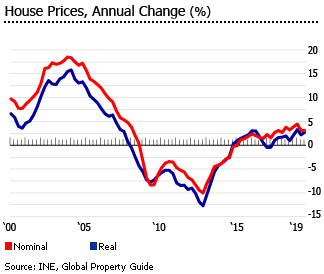
By property type:
- Existing dwellings: prices rose by 4.41% during the year to Q3 2019 (4.08% inflation-adjusted), the slowest growth in three years.
- New dwellings: prices rose by 6.64% y-o-y in Q3 2019 (6.31% inflation-adjusted), following annual rises of 7.17% in Q2 2019, 10.35% in Q1 2019, 8.03% in Q4 2018 and 6.13% in Q3 2018.
The Bank of Spain reports lower house price rises. During the year to Q3 2019, nationwide house prices rose by a modest 3.07% (2.75% inflation-adjusted). On a quarterly basis, house prices were up by a minuscule 0.05% in Q3 2019 (0.73% inflation-adjusted).
After seven long years of house price declines, Spain’s housing market only returned to growth in 2015. Spanish house prices had fallen by a total of 36.3% (-42.9% inflation-adjusted) from Q3 2007 to Q1 2015, with existing home prices falling by as much as 43.1% (-49% inflation-adjusted), based on figures from INE. There were 24 consecutive quarters of y-o-y declines.
| SPAIN’S HOUSE PRICE INDEX, ANNUAL CHANGE (%) | ||
| Year | Nominal | Inflation-adjusted |
| 2008 | -3.21 | -5.53 |
| 2009 | -6.25 | -6.39 |
| 2010 | -3.53 | -5.93 |
| 2011 | -6.78 | -9.27 |
| 2012 | -10.02 | -12.72 |
| 2013 | -4.20 | -4.32 |
| 2014 | -0.26 | 0.25 |
| 2015 | 1.85 | 2.17 |
| 2016 | 1.47 | 0.49 |
| 2017 | 3.09 | 1.62 |
| 2018 | 3.86 | 2.11 |
| Sources: Bank of Spain, Global Property Guide | ||
Demand is slowing gradually. Home sales in Spain fell by 3.1% in the first ten months of 2019 compared to the same period last year, to 427,638 units, after increasing by 10.8% in 2018, 15.4% in 2017, 14% in 2016 and 11.5% in 2015, according to the Instituto Nacional de Estadistica (INE). The number of transactions for second-hand houses dropped 4% but increased slightly by 1.3% for newly built houses.
The surge in home sales in recent years was mainly driven by foreigners buying homes on the coast and in cities like Barcelona and on the Costa del Sol, one of the country’s most popular areas with overseas purchasers. Most foreign homebuyers are Britons, French, Germans, Belgians, Italians and Swedes.
Construction activity is weakening again, after reaching a seven-year high in 2018. During the first seven months of 2019, the number and area of residential building permits fell by 23.7% and 10.6%, respectively.
Foreclosures rose by 11% during the first three quarters of 2019 from the same period a year earlier to 21,039 dwellings, based on figures from the INE. Foreclosures for new dwellings increased by 36.9% and by 4.4% for existing dwellings.
Despite slowing economic growth, the outlook for Spain’s housing market remains upbeat, with house prices expected to rise by 5.5% in 2020, the largest rise of eight European countries included in a recent Moody’s forecast. According to Moody’s the Spanish housing market now faces low risks due to stringent mortgage lending conditions and the rise in popularity of fixed rate mortgages. In October 2019, fixed rate mortgages represented 45.3% of all new loans contracted, up from 39.8% share in a year earlier, and from just about 3% a decade ago, according to INE.
In 2019, the economy expanded by 2%, a slowdown from the prior year’s 2.4% growth and the slowest expansion since 2014. The Bank of Spain expects economic growth to slow further to 1.7% this year and 1.6% in 2021. In fact, the European Commission is even more pessimistic, projecting the Spanish economy to grow by just 1.5% this year and by 1.4% next year.
Foreigners have a right to buy and resell all kinds of property - residential, commercial or land, with no limits.
House prices soaring in the Balearics and Canary Islands
Most regions saw house price rises during the year to November 2019.
- In capitals and big cities, house prices rose by 4.6% y-o-y to an average of €1,649 per sq. m in November 2019, according to TINSA.
- In metropolitan areas, house prices rose by 2.5% to an average of €1,382 per sq. m. in November 2019 from a year earlier.
- On the Mediterranean Coast, house prices increased by a miniscule 0.3% y-o-y to an average of €1,468 per sq. m.
- In the Balearic and Canary Islands, house prices soared 11.3% y-o-y to an average of €1,604 per sq. m.
- In the rest of municipalities, house prices rose slightly by 1.3% to an average of €1,410 per sq. m.
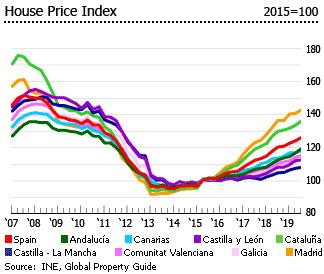
Currently, the most expensive housing in Spain is in San Sebastian, a resort town on the Bay of Biscay in the mountainous Basque community, followed by Barcelona, and Madrid, with prices in these areas ranging from €3,000 to €3,600 per sq. m.
Spanish house prices now only 41% below peak!
From 1996 to 2007, Spain’s national average house price rose by 197% (117% inflation-adjusted), one of Europe’s highest house price increases. The price of coastal properties surged 250% (155% inflation-adjusted) from 1996 to 2007, as hundreds of thousands of foreigners, mainly from the UK, France and Germany, bought property.
In Madrid and Barcelona house prices rose 188% (109% inflation-adjusted) from 1996 to 2007, while prices in other inner provinces rose by 175% (101% inflation-adjusted).
The boom ended abruptly in 2008. The housing slump battered the Spanish economy, and brought spiraling unemployment. Developers were left with blocks of unsold properties and massive debts.
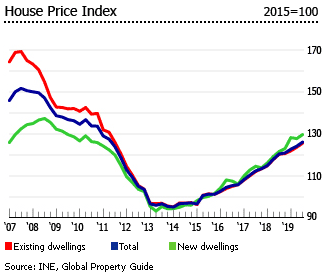
Despite the price rises in the past four years (2016 to 2019), nationwide house prices are still about 33% (-41% inflation-adjusted) below the peak levels seen before the global crisis.
Yields back to normal levels
Gross rental yields on property in Spain have returned to normal, according to Global Property Guide's research on Spanish yields. In some places in Spain, but only for the smallest sized apartments, buying an apartment is now attractive from a yields perspective - a completely new situation for Spain.
For apartments in Barcelona’s Ciutat Vella, gross rental yields - the return earned on the purchase price of a rental property, before taxation, vacancy costs, and other costs - range from 4.40% to 5.15%. Similar yields, or maybe slightly lower, can also be had in Madrid. All these yields figures are higher than last year, which was higher than the previous year. Spain is once again beginning to look a possible investment destination.
Dramatic land price rises in Madrid and some other Spanish cities, despite falling transactions
The average price of urban land transactions in Spain rose by 4.5% to €162 per sq. m in Q3 2019 from a year earlier, according to the Ministry of Development.
Fourteen of the 17 autonomous communities where figures are available saw land price rises during the year to Q3 2019:
- In Madrid, average urban land prices soared by 34.4% to €338.4 per sq. m.
- In Andalucia, land prices increased 6.4% to an average of €170.9 per sq. m.
- In Cataluña, the country’s second largest region, land prices rose by 5.3% to an average of €184 per sq. m.
- In Castile-La Mancha, the average land price was up slightly by 0.4% to €85 per sq. m.
- In Galicia, land prices surged by 22.7% to an average of €104 per sq. m.
- In Castilla y Leon, the average land price rose by 19.6% to €66.3 per sq. m.
- In Canary Islands, average land price increased 22.7% to €244.6 per sq. m.
- In Valencian Community, average land price fell slightly by 1.5% to €158.2 per sq. m.
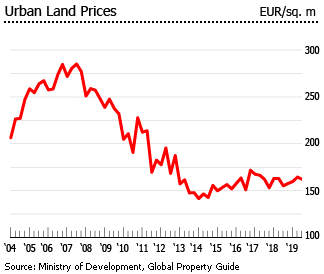
The number of land transactions fell by 17.1% y-o-y during the first three quarters of 2019, and their value fell by 15.1%, according to the Ministry of Development.
Home sales are falling again
Home sales in Spain fell by 3.1% to 427,638 units in the first ten months of 2019 compared to the same period last year, after increasing 10.8% in 2018, 15.4% in 2017, 14% in 2016 and 11.5% in 2015, according to the Instituto Nacional de Estadistica (INE).
The number of transactions for second-hand houses was down by 4% to 349,030 units in the first ten months of 2019 from a year earlier, according to the INE. On the other hand, transactions of newly built houses increased slightly by 1.3% y-o-y to 78,608 units.
Almost half of the autonomous regions and cities saw falling demand. During the first ten months of 2019, Santa Cruz de Tenerife recorded the biggest fall in sales of 15.9%, followed by Canarias (-14.5%), Las Palmas (-13.2%), Soria (-13%), Lugo (-12.2%), Balears (-11.7%), Navarra (-11.2%) and Melilla (-11.2%). There were also declines in Madrid (-6.4%), Valencian Community (-5.2%), Barcelona (-2.7%), Andalucia (-1.8%), and Cataluña (-1.4%). In contrast, Ceuta registered the biggest sales surge of a whopping 103.9% y-o-y in the first ten months of 2019, followed by Avila (23.6%), A Coruña (11.9%), Ciudad Real (10.7%), Toledo (9.7%) and Palencia (9.5%).
The modest decline might be due to the fact that home sales reached almost 518,000 units in 2018, up 10.8% from a year earlier and the highest level since 2008 – an indication that demand is back at its pre-crisis levels.
Foreign demand is weakening
Home sales to foreigners were 4.8% down from a year earlier in the second quarter of 2019, according to the Property Registrars – the third consecutive quarter of y-o-y declines.
Foreign investors started to return to the Spanish property market in 2014. In 2018, foreign homebuyers bought over 65,500 homes in Spain, up 7.4% from a year earlier, following annual growth of 13.7% in 2017. In recent years, foreign homebuyers accounted for about 12% to 20% of all home sales in Spain annually, sharply up from just a 4.24% share in 2009.
Britons remain the number one foreign homebuyers in Spain in H1 2019, making 14% of all home purchases by foreigners in H1 2019, followed by the French, Germans, Romanians and Moroccans. Other buyers include Swedes, Belgians, Italians and Chinese.
The Golden Visa scheme, fully applicable since 30th September 2013, has increased interest not only from the Middle East but also Asia and Russia. Any non-EU national bringing more than €500,000 to invest is automatically granted a Spanish residency permit.
In the first half of 2019, there were about 848 approved Golden visa applicants, up 18.4% from a year earlier - the highest figure ever recorded.
Since its introduction, the Golden Visa scheme has attracted 4,941 successful applicants, with Chinese and Russian investors representing more than 60% of money invested. Spain received €2.5 billion in foreign investment as a result. An overwhelming majority of applicants choose real estate acquisition as a qualifying investment.
The Balearic Islands are especially attractive to foreigners with about one third of total demand coming from foreigners, mainly due to its white-sand beaches and sunny Mediterranean landscape. It is followed by the Canary Islands, Valencian Community, Murcia, and Andalucia.
Foreclosures are rising again
Foreclosures rose again by 11% to 21,039 dwellings during the first three quarters of 2019, following y-o-y declines of 5.3% in 2018, 32.9% in 2017, 31.2% in 2016 and 14.8% in 2015, according to the INE.
By dwelling type:
- Existing dwellings: 15,775 units in Q1-Q3 2019, up 4.4% a year earlier
- New dwellings: 5,264 units, up 36.9% a year earlier
Of the autonomous regions and cities, Galicia registered the biggest increase in foreclosures of 78.9% y-o-y in the first three quarters of 2019, followed by Murcia (42.6%), Cataluña (36.7%), Castile-La Mancha (23.7%), Valencian Community (13.9%), Extremadura (13%), Andalucia (8.8%), and Aragón (7.4%).

In contrast, foreclosures continue to decline in La Rioja (-87.2%), Canarias (-50.4%), Navarra (-43%), Ceuta (-40%), Melilla (-33.3%), Asturias (-30.1%), Pais Vasco (-25.6%), and Madrid (-20.5%).
Foreclosures were almost steady in Castilla y Leon, Balears, and Cantabria.
Cataluña, Andalucia, and Valencian Community accounted for almost two-thirds of all foreclosures during Q1-Q3 2019.
No more housing oversupply; construction activity slowing
Spain’s housing market is now close to being balanced after being massively oversupplied. The oversupply of homes reached its peak in 2010, when the surplus stock amounted to 931,615 homes, according to the Institute of Business Practices (el Instituto de Práctica Empresarial or IPE). Residential building permits averaged 160,000 annually from 2000 to 2007. But the surplus of homes fell by 41% from 662,761 homes in 2014 to just 389,000 homes in 2015, due to strong demand.
With home sales of about 410,000 units per year from 2014 to 2018 and completions of just 51,000 annually, it is believed that the housing glut has been finally corrected. In fact, some allege there is now a growing housing shortage.

However construction activity is slowing again, after reaching a seven-year high in 2018. During the first seven months of 2019, the number and area of residential building permits fell by 23.7% and 10.6%, respectively.
Spanish interest rates are amazingly low
Following post-crisis European Central Bank (ECB) key rate reductions, average mortgage rates in Spain dropped to 1.29% in December 2016, and have held steady since. In November 2019, the average mortgage rate in Spain was 1.22%, almost unchanged from a year earlier, according to the European Central Bank (ECB).
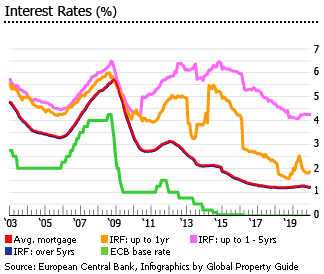
In November 2019:
- The interest rate for housing loans with initial rate fixation (IRF) of up to 1 year stood at 1.85%, up from 1.76% in November 2018 but still down from 2.29% two years ago.
- The interest rate for housing loans with IRF between 1 and 5 years was 4.25%, up from 4.13% in the previous year but down from 4.7% two years earlier.
- The interest rate for loans with IRF of over 5 years was 1.21%, almost unchanged from a year earlier.
Spain’s housing market has traditionally been extremely vulnerable to interest rate changes, given that before 2004 more than 80% of new mortgages had initial rate fixations (IRF) of less than 1 year, a proportion which rose to 90% from 2005 to 2006.
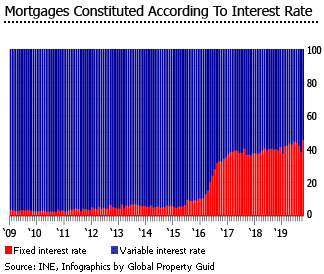
However, there has been a continuous decline in the share of adjustable rate mortgages in recent years. In October 2019, fixed rate mortgages represented 45.3% of all new loans contracted, up from 39.8% share in a year earlier, and from just about 3% a decade ago, according to INE.
Mortgage market remains weak
Despite ultra-low interest rates, the Spanish mortgage market continues to shrink. It contracted to about 41.1% of GDP in 2019, down from 42.8% of GDP in 2018, 44.9% in 2017, 48.1% in 2016, 51.3% in 2015 and 61.5% in 2011, based on figures from the Global Property Guide.
New home mortgages increased by a minuscule 0.1% y-o-y to 289,289 during the first ten months of 2019 – far below the annual average of 1.13 million new home mortgages granted from 2003 to 2008.
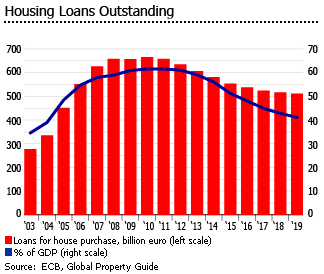
The average mortgage term is now 24 years, according to INE.
Rents rising at a slower pace
Average apartment rents in Spain rose by 2.7% to €8.52 per sq. m. in the first half of 2019, slower than the increases of 3.7% in H1 2018, 8.3% in H1 2017, 5.7% in H1 2016, and 4.4% in H1 2015, according the real estate portal Fotocasa.
By autonomous region, Cantabria recorded the highest rent increase of 13.2% in H1 2019, followed by Murcia (8.5%) and Valencia (7.5%). In contrast, La Rioja (1.8%), Castile-La Mancha (1.9%) and the Balearic Islands (2.1%) registered the slowest growth in rents.
Madrid is the most expensive community to rent existing homes, with an average monthly rent of €13.51 per sq. m. in H1 2019, according to Fotocasa. It was followed by Catalonia with an average rent of €12.59 per sq. m., Basque Country (€10.82 per sq. m.), the Balearic Islands (€10.04 per sq. m.), Cantabria (€8.38 per sq. m.), and the Canary Islands (€7.84 per sq. m.).
Rent control law introduced
In March 2019, a new government decree regulating rental dwellings in Spain went into effect, in an effort to limit rent increases and expand tenant protection and rights.
Among the major changes, the measure caps annual rent hikes at the rate of inflation within the contract period; extends the duration of the rental contract from 3 years to 5 years (or 7 years if the landlord is a business entity); and introduces a state benchmark index for rental prices that will be used to gauge the current state of the market. The new law will be applied to new lease agreements signed on March 6, 2019 onwards.
Spanish economy slowing, but unemployment continues to fall
Spain’s economy, the eurozone’s fourth largest economy, started to recover in 2014 with GDP expanding by 1.4%, according to the International Monetary Fund (IMF). In January 23, 2014, Spain became the second euro zone country to exit its international bailout program, after Ireland. The Spanish economy has consistently outperformed much of Europe since.
However, it has been a long, hard slog. Recession has been Spain’s normal condition for years, mainly due to the adverse impact of the global financial meltdown and the Eurozone debt crisis. The economy shrank by 1.7% in 2013, according to the IMF, by 2.9% in 2012 and by 1% in 2011. In 2010, the economy grew by a meager 0.02%, after a contraction of 3.6% in 2009.
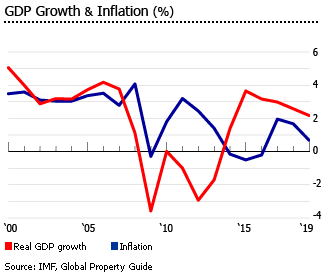
In 2019, economic growth slowed to 2%, as consumer demand waned and business investment weakened.
The Bank of Spain expects economic growth to slow further to 1.7% this year and 1.6% in 2021. The European Commission is even more pessimistic, projecting the Spanish economy to grow by just 1.5% this year and by 1.4% next year.
Spanish unemployment fell to 13.92% in Q3 2019, down from the previous year’s 14.55% and from an annual average of about 22% from 2010 to 2017, according to INE. Despite this, Spain’s unemployment is still the second highest in the OECD, next to Greece. The total number of unemployed is 3.1 million.
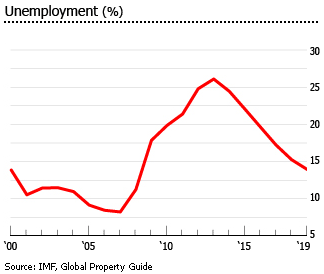
Inflation is expected to remain low at 1.1% this year, according to the European Commission.
Spain narrowed its budget deficit to around 2.3% of GDP in 2019, down from 2.5% in 2018, 3% in 2017, 4.3% in 2016, 5.2% in 2015, 6% in 2014, 7% in 2013 and 10.5% in 2012. The deficit is expected to fall further to 2.2% of GDP this year, according to the European Commission. Spain’s gross public debt stood at an unremarkable 96.7% of GDP in 2019.
In November 2019, Spain’s governing Socialists, led by Prime Minister Pedro Sánchez, have won the country’s fourth election in four years, but remain short of a majority. In January 2020, Sánchez successfully formed a minority coalition government with the left-wing Podemos party. Sánchez took over as prime minister in June 2018, after his conservative predecessor Mariano Rajoy lost a parliamentary vote of confidence amidst a long-running corruption trial involving members of his Popular Party.
Sources:
- Tinsa Report November Rise of 3.7 Per Cent in Spanish Property Values (MAS Property Marbella): https://www.maspropertymarbella.com/tinsa-report-november-rise-of-3-7-per-cent-in-spanish-property-values/
- Spanish House Prices to Rise 5.5% in 2020, Moody’s forecast (Private Property): http://www.privateproperty.es/news/spanish-house-prices-to-rise-5-5-in-2020-moodys-forecast/
- World Economic Database (International Monetary Fund): https://www.imf.org/external/pubs/ft/weo/2019/02/weodata/index.aspx
- Building construction (Ministerio de Fomento): https://www.fomento.gob.es/informacion-para-el-ciudadano/informacion-estadistica/construccion/construccion-de-edificios/construccion-de-edificios-licencias-municipales-de-obra
- Total of property transfers recorded in the land registries - October 2019 (Instituto Nacional de Estadistica): https://www.ine.es/dyngs/INEbase/en/operacion.htm?c=Estadistica_C&cid=1254736171438&menu=ultiDatos&idp=1254735576757
- Construction and housing (Instituto Nacional de Estadistica): https://www.ine.es/dyngs/INEbase/en/categoria.htm?c=Estadistica_P&cid=1254735576757
- Urban land price statistics (Ministerio de Fomento): https://apps.fomento.gob.es/BoletinOnline2/?nivel=2&orden=36000000
- Statistical Bulletin (Banco de España): https://www.bde.es/webbde/en/estadis/infoest/bolest.html
- Housing Price Index. Base 2015 - Quarter 3/2019 (Instituto Nacional de Estadistica): https://www.ine.es/dyngs/INEbase/en/operacion.htm?c=Estadistica_C&cid=1254736152838&menu=ultiDatos&idp=1254735576757
- Registration of certifications of foreclosures begun in the land register - Quarter 3/2019 (Instituto Nacional de Estadistica): https://www.ine.es/dyngs/INEbase/en/operacion.htm?c=Estadistica_C&cid=1254736176993&menu=ultiDatos&idp=1254735576757
- Gross rental yields in Spain have returned to normal (Global Property Guide): https://www.globalpropertyguide.com/Europe/Spain/Rental-Yields
- Economic forecast for Spain (European Commission): https://ec.europa.eu/info/business-economy-euro/economic-performance-and-forecasts/economic-performance-country/spain/economic-forecast-spain_en
- Spanish economy to gradually slow down through 2022 as consumer demand wanes (Nasdaq): https://www.nasdaq.com/articles/spanish-economy-to-gradually-slow-down-through-2022-as-consumer-demand-wanes-2019-12-16
- Economically Active Population Survey - Quarter 3/2019 (Instituto Nacional de Estadistica): https://www.ine.es/dyngs/INEbase/en/operacion.htm?c=Estadistica_C&cid=1254736176918&menu=ultiDatos&idp=1254735976595
- Spain employment reaches highest level in history, however job creation at lowest in six years (Euro Weekly): https://www.euroweeklynews.com/2020/01/04/spain-employment-reaches-highest-level-in-history-however-job-creation-at-lowest-since-2013/
- Spain Government Budget (Trading Economics): https://tradingeconomics.com/spain/government-budget
- Spain Government Debt to GDP (Trading Economics): https://tradingeconomics.com/spain/government-debt-to-gdp
- Q1 2019 foreign demand for property in Spain: first decline since the recovery began (Spanish Property Insight): https://www.spanishpropertyinsight.com/2019/07/19/q1-2019-foreign-demand-for-property-in-spain-first-decline-since-the-recovery-began/
- Q2 2019: Where do foreigners buy property in Spain? (Spanish Property Insight): https://www.spanishpropertyinsight.com/2019/10/25/q2-2019-where-do-foreigners-buy-property-in-spain/
- Golden Visa Approvals Surge in Spain (La Vida Golden Visas): https://www.goldenvisas.com/spain-golden-visa-surge
- Up 80%: Approvals for Spain’s Residence by Investment Program Hit All-Time High in H1 2019 (Investment Migration Insider): https://www.imidaily.com/europe/up-80-approvals-for-spains-residence-by-investment-program-hit-all-time-high-in-h1-2019/
- The headwinds facing the Spanish property market at the end of 2019 (Spanish Property Insight): https://www.spanishpropertyinsight.com/2019/12/27/the-headwinds-facing-the-spanish-property-market-at-the-end-of-2019/
- Spain country profile (BBC News): https://www.bbc.com/news/world-europe-17941641
- The rate of increase in rental prices is slowing (Testa Residencial Socimi, S.A.): https://www.testaresidencial.com/en/the-rate-of-increase-in-rental-prices-is-slowing/